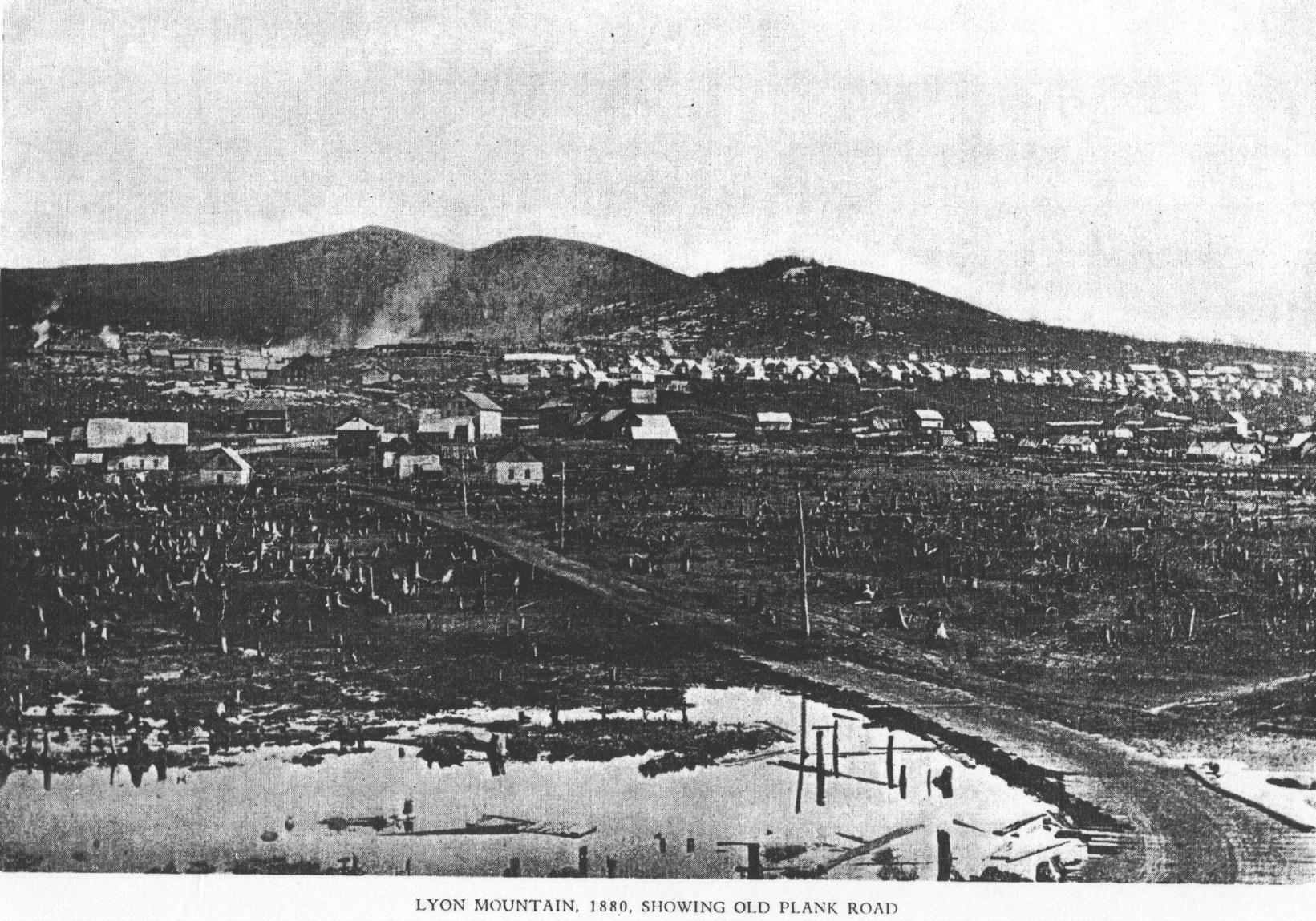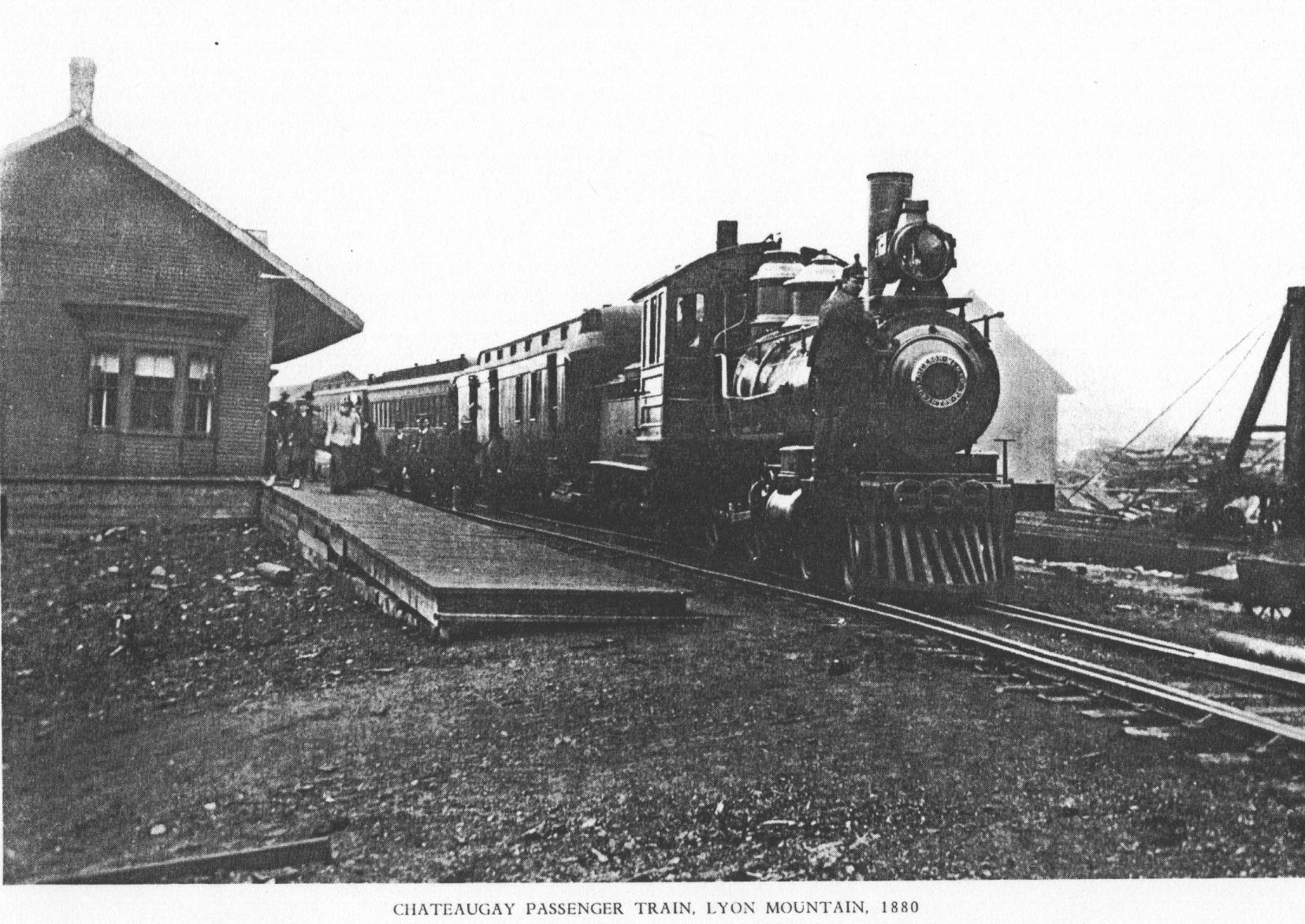
The blooms and billets were hauled by wagons and sleighs to Chateau-
gay, N.Y., and shipped
via the Ogdensburg & Lake Champlain Railroad to the
steel districts of Pennsylvania
and Ohio. There is no doubt but that the
same inherent qualities
of the Chateaugay iron, which are in demand by the steel
men of today for their
toughest projects, were known and appreciated during this
period. The records
at this time indicate a large tonnage of Chateaugay blooms
being made for shipment
to the wire manufacturers for the Brooklyn Bridge.
The Catalan forge furnace, in which iron was made direct from ore, was
an open hearth, about
2 1/2 feet by 3 1/2 feet, with a stack 20 feet to 25 feet high
for carrying off the
gases.
The blast of air was usually furnished either by a bellows, or by means
of a trompe. The
pipe thai carried the air to the hearth was coiled in the
stack of the furnace,
the object being to preheat the blast of air, which resulted
in a saving of fuel.
The operation consisted of a charcoal fire, stimulated by a blast of air,
iron ore and charcoal
in small quantities being added alternately by the blooms-
man, who also regulated
and adjusted the fire, until the batch of iron, called a
"loupe," weighing about
300 pounds, was made. This usually took about
three hours.
The "loupe," in a pasty state, mixed with slag, was loosened in the
hearth by means of bars,
and then lifted from the furnace with tongs, known as
"grampuses," promptly
taken to the trip hammer and forged into blooms or
billets, a bar of iron
about 5 inches square, varying in lengths from two to
six feet, depending upon
the market demands.
The iron made was exceptionally pure. The following is an analysis
made recently in the
Company's laboratory of one of the old Chateaugay blooms
which has been preserved:
Iron
99.70 %
Silicon ..
.08
Sulphur
.017
Phosphorus
.017
Combined Carbon
.130
Manganese
Nil
The Company at this time was fairly prosperous. The following was
told of the late Hon.
John Moffitt, who for a number of years was President
of the Plattsburg National
Bank & Trust Company:
"It seems that in the early ' 70's Mr. Moffitt was General Manager
of the Chateaugay Company's operations. His responsibilities as Man-
ager included the purchase of the Company's supplies, the payment of
bills, the sale of products, and the collection of all money due the Com-
pany. Shortly after the close of one successful year, the Company
having manufactured and sold some 4,000 tons of iron, the late Hon.
Smith M. Weed, President of the Company, asked Mr. Moffitt how
much money the Company made during the past year. The reply
represented a very substantial profit. Mr. Weed promptly said that
he
had been to see the bookkeeper, and was quite sure that the books did
not show net earnings anywhere near this amount. Mr. Moffitt
promptly replied that he did not care what the books showed. He had
paid all of his bills and had that much money left in the bank."
This early period of development, however, was accompanied by a great
deal of hardship for
both the management and the employees. The winters
were cold, with heavy
snows, making it very difficult at times to obtain food
and clothing. Wild
meat, in the form of venison, rabbits, birds and fish, was
quite plentiful and,
had it not been for this, there would have been a great deal
more suffering than there
was. Flour, one of the necessities of these hard labor-
ing pioneers, was lacking
for months at a time, and was obtained, when possible,
at a premium.
Late in the '70s, the Company realized that in order to develop proper-
ly the rich resources
of its property to the best advantage, it must secure rail-
road communication with
the great iron markets of the country. The ques-
tion was, which way should
it strike out from the mine, lying in the very
heart of the wilderness.
Two routes were open to it: One down the
Chateaugay valley to
Chateaugay, N. Y., connecting with the Ogdensburg and
Lake Champlain Railroad,
and the other to Dannemora, to connect with the
Plattsburg & Dannemora
line. In February, 1879, when the snow was four
feet deep in the woods,
the work of making a preliminary survey was com-
menced, and early in
the spring the following data were at hand: Distance to
Chateaugay, 17 miles,
an almost straight line, with an easy grade all the way,
and the line running
nearly half way through the Company's own land, past
its Catalan forge at
Belmont, and the other half through a fine farming coun-
try, from which considerable
local traffic would be derived. Distance to Danne-
mora, 17 miles, ten of
which lay through solid wilderness, a crooked line
running around two mountains
and alternately toward all points of the com-
pass; a hard line to
grade, with the promise of little local traffic. Everything
seemed to indicate the
selection of the Chateaugay route as the most natural,
cheapest and best.
However, Thomas Dickson, President of the Delaware and Hudson
Canal Company, a close
friend of Smith M. Weed, concluded that the proper
movement of this ore
was to Plattsburg, then via the New York and Can-
ada Railroad. On
the 20th of May, 1879, the Chateaugay Railroad was
organized, with Thomas
Dickson as its President. Subsequently, the lease of
the Plattsburg and Dannemora
Railroad was secured from the State, and about
the 5th of June the contract
was let for grading of the Chateaugay Railroad
from Dannemora to the
Ore Bed. On the 8th of June the work began, and on
December 6th the track
laying was finished to the first shaft. On the 17th of
December, the first regular
train ran over the entire line, and on December 18,
1879, the first train
of ore was moved to Plattsburg.

lmrr1880.jpg = fullsize
In the subsequent years, the operations at Lyon Mountain spread out
and increased at a rapid
rate. Directly above the "Old Opening" shaft, where
the first blow was struck
toward developing the Chateaugay Ore Bed in 1867,
and continuing southwest
along the strike of the vein, the Williams Opening
shaft had been sunk to
a depth of approximately 200 feet. Between the shafts
was an engine house,
36 x 52 feet, housing a compressor for air drills, and
pumping and hoisting
apparatus for both shafts.
Farther along was the railroad station, a building which now contains
the offices of the present
Company, and directly across the tracks a building
40 x 50 feet, with two
stalls for housing locomotives, had been erected. Adjoining
this was the machine
shop, 36 x 65 feet, with a second story for a carpenter
shop. This department
contained the most up-to-date iron lathes, planers,
drills, and other tools
needed to repair or rebuild engines or machinery, or to do
car repair work.
On the east bank of Separator Brook, an engine house 40 x 50 feet,
housing a 200 horse power
engine, designed to drive the separator, tools in the
machine shop, and hoisting
apparatus, was erected. On the opposite side of the
brook was No.2 Separator,
40 x 60 feet. Above, on the slope, were the roast-
ing kilns, alongside
of which was a side track from which ore from all shafts, to
be separated, was dumped
directly into the kilns, and thence worked down to
the ground floor of the
building, which was furnished with a Blake jaw crusher
and a revolving Conkling
separator. A short distance above was a substantial
dam. Cars were
loaded direct from the separator and hoisted by an engine on
an elevated track to
the main track.
At this time the vein was uncovered for about 1,500 feet. Shafts
had
been sunk at numerous
locations west of No.2 Separator and were equipped
with up-to-date steam
hoisting apparatus, steam pumps, and steam-driven com-
pressors for the air
drills. The average width of the vein was 20 to 25 feet,
the depth unknown.
Go to Mine History Page 3 .........
![]()

